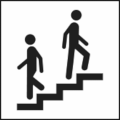Facts and data on pictograms

Synonyms / Other Terms Used
Stair, Steps, Stairway, Staircase
Category
Public Facilities, Guidance & Information, Travel
Message / Function
To indicate the location of stairs. Shall not be used to indicate or identify an escalator.
| Source | Description | |
|---|---|---|
 |
ISO 7001 | Stair profile with two human figures, one walking up, one walking down |
 |
CNIS | Stair profile with two human figures, one walking up, one walking down |
 |
Eco-Mo Foundation |
Stair profile with two human figures, one walking up, one walking down |
 1) 1) |
ON Testdesign | Stair profile with two human figures, one walking up, one walking down |
 2) 2) |
ON Testdesign | Stair profile with two human figures, one walking up, one walking down |
 |
Dreyfuss | Two human figures on stair profile with floor transitions ending in arrows |
 |
CHBA | Human figure on stair profile walking upwards |
 |
TC | Human figure with case on stair profile walking upwards |
 |
PC | Human figure on stair profile walking upwards |
 |
O'72 | Human figure on stair profile walking upwards |
 |
MTA | Human figure on stair profile walking upwards |
 |
BS 8501:2002 | Human figure approaching stair profile |
 |
Signbox | Human figure approaching stair profile |
 |
Schweiz-Mobil | Human figure approaching stair profile from floor transition |
 |
Zurich Airport | Human figure approaching stair profile from floor transition |
 |
Wiener Linien | Stair profile with floor transitions |
 |
Schiphol | Stair profile |
 |
AIGA | Stair profile |
 |
Picto'grafics | Stair profile |
 |
S/TA | Stair profile |
 |
D/FW | Stair profile ending in floor transition with arrow head |
 |
UIC | Stair profile with floor transitions, arrow head at top |
 |
Sekta | Stair profile with hand rails |
 |
Smitshuijzen | Stair profile, slanted line |
Note: Some of the examples shown above were mirrored horizontally to contrast differences.
Discussion
In the ISO 1975 Test Series, an international study conducted in Argentinia, Australia, Canada, India, The Netherlands, and Spain (Easterby & Zwaga 1976), the AIGA variant dropped out already at a preliminary stage of research, as it was not among the top six pictograms based on the results of the Appropriateness Ranking Test conducted. Variants ranked best all included representations of persons on stairs.
Looking at the primary misinterpretations revealed in the Comprehension Test conducted in this study, it becomes obvious that they are based on displaying just one person moving into a specific direction (responses like Upstairs, Up, Downstairs, etc.).
In a follow-up Matching Test (Easterby & Zwaga 1976) the three pictogram variants examined all reached about 90 % correct responses.
On basis of these results the AG 133.06 Working Group Pictogram Design created several test designs. Two of them - marked with 1) and 2) in the table above - then were examined applying a Comprehension Test conducted in Austria (Brugger, 1979). Both variants exceeded minimum requirements defined by ISO, but with 82 % correct responses variant 1) seemed to be a slightly better solution. After a further redesign this concept finally was used as ISO guideline example.
In the Japanese study to propose domestically unified graphical symbols based on scientific methods, the pictogram variant labeled as Eco-Mo Foundation proved to be well comprehensable with a comprehension score of 89.7 (Eco-Mo Foundation, 2001). The positive results for this variant, which corresponds to ISO Public Information Symbol PI PF 021 concerning the verbal description of the image content, confirm the work of ISO/TC 145/SC 1.
Recommendation

We recommend using Public Information Symbol PI PF 021 (formerly pictogram 011) of ISO 7001, which was developed to eliminate the aspect of direction by displaying two persons with differing walking direction. Where the stairs are unidirectional, the figure walking up or the figure walking down should be omitted, as appropriate.
Tests of pictograms of referent Stairs
Brugger, Ch. (1979): Abschlußbericht über den Erkennungstest. Report to the Austrian Standards Institute (ON) dated 09/79, Vienna.
Easterby, R.S. & Zwaga, H.J.G. (1976): Evaluation of Public Information Symbols, ISO Tests: 1975 Series. AP Report 60, Department of Applied Psychology, University of Aston, Birmingham, March 1976.
Eco-Mo Foundation (2001): Test data of public information symbols in Japan - Procedure for the testing of public information symbols by the Study Committee. ISO: ISO/TC 145/SC 1 N 329.
See also
Updated 2023-10-12